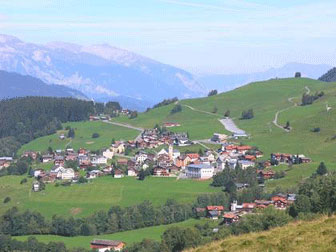Obersaxen, the "Walserinsel" (Walser Island) in the Roman linguistic area
|
Immigration of the Walser In the 12th and 13th centuries German speaking Walliser immigrated here. Their origin, Obersaxen, is not confirmed through any Freiheitsbreif. For the settlement of Walser, the monastery Disentis played an important role as in the 13th century it extended its rule from the Herrschaft vom Rhonegletscher up to Petersbach in Obersaxen. Old monastery chronicles report that monks and abbots from Wallis worked in Disentis. In the year 1213 there was only one non-walser monk living in the convent. |  |
Under the Walser is Anricus de Sursaxa (from Obersaxen) specified. Therefore a small number of Walser must have already been resident in Obersaxen at this time. This assumption is confirmed by the names Anricus and Henricus which, according to language researchers, developed later into the surnames Hendry and Henny.
From the year 1288 the monastery Disentis decided upon an alliance in Ursern with five Walliser aristocrats of Lombardi descent, who appeared at that time in Goms as Lehensherren of the Bishops von Sitten. These Lehensherrn and the monastery were interested in clearing new alpine land and making it cultivatable in order to secure their position and claim control of the alpine transition ways. Here, one could object and say that Obersaxen doesn’t lie on an Alpine transition. However, it is well known that the Obersaxer went to the cattle markets in Bellinzona (Belenz) and Lugano (Lauis). They didn’t therefore only use the Lukmanier, they had in the “alten Lugnezerweg” or the “Nallpass” over the saddle by Alp Nova a connection to Vrin, Diesrut- and Greinapass. Then in 1730 the Oberaxer Landbuch bezug, due to an earlier epidemic, imposed a market driving ban to Vrin.
Obersaxen is therefore one of the earliest, if not the oldest Walser settlement that still exists in Graubündens. It is certain that the Walliser, at least partly, stopped off first in Urserental. The Urseren maintained a long and durable relationship with Obersaxen. This was still evident in 1519 when the Rechnungsbuch von Urseren gave the Ammann of the church in Obersaxen half a Gulden.
Another circumstance points to direct contact between Obersaxen and Wallis and have favoured a longer persisting immigration. In 1398 Landvogt Guitschart von Raron married the widow Margaretha, born Rhäzüns, which brought in parts of the goods interest in Obersaxen for her husband.
At that time Obersaxen was at least 100 years under the rule of the Herrschaft Rhäzüns and subject to the payment of interest and this remained this way until 1819. In this year the Rhäzüner possession administered by Austria changed over to the Kanton Graubünden. Obersaxen brought loosely and freely around twenty times more than the annual farm interest with 4400 guldens to the Kantonkasse.
In connection with the epidemic mentioned above it is also reported that the “Altvordern” in Wallis had a St. Joderheiligtum (relic) in Wallis which could be found in the weather bell. Bishop Theodul is specified in the consecration documents of the parish church in Meierhof 1441, 1473 and 1500 as one of the holy side altars.
Literature
Martin Bundi, Zur Besiedlungsgeschichte Graubündens im Mittelalter, Chur 1982.
M.Ettlin-Janka, Obersaxer Wörtersammlung, Buochs 1995.
P.Iso Müller, Geschichte der Abtei Disentis, Zürich 1971.
Enrico Rizzi, Geschichte der Walser, Chur 1993.
Internet
www.prosupersaxa.ch
(Ressource: www.obersaxen.ch)









